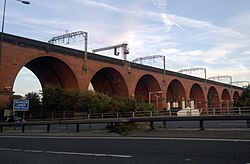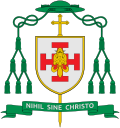| St Joseph's Church | |
|---|---|
 View from St Petersgate | |
 St Joseph's Church | |
| 53°24′34″N2°09′28″W / 53.4095°N 2.1578°W | |
| OS grid reference | SJ8960990315 |
| Location | Stockport, Greater Manchester |
| Country | England |
| Denomination | Roman Catholic |
| Website | St Joseph's, Stockport |
| History | |
| Status | Active |
| Dedication | Saint Joseph |
| Architecture | |
| Functional status | Parish church |
| Heritage designation | Grade II listed |
| Designated | 16 September 1985 [1] |
| Architect | Matthew Ellison Hadfield |
| Style | Gothic Revival |
| Groundbreaking | 1861 |
| Completed | 1862 |
| Administration | |
| Province | Birmingham |
| Diocese | Shrewsbury |
| Deanery | Stockport & Tameside [2] |
St Joseph's Church is a Roman Catholic Parish church in Stockport, Greater Manchester, England. It was built from 1861 to 1862 and designed by Matthew Ellison Hadfield. It is situated on St Petersgate, south west of the High Street. Until 31 August 2022 it was the only church in England administered by the Priests of the Sacred Heart [3] at which date it was transferred to be designated as Eucharistic Shrine for the Diocese of Shrewsbury. As part of this change, times for Eucharistic adoration have been made available in addition to the continued life of the parish. [4] [5] The church building is Grade II listed building. [6] [7]









